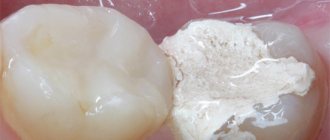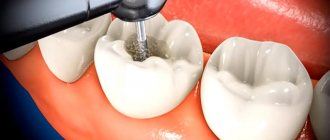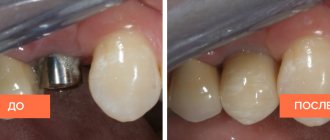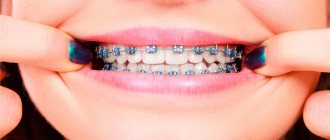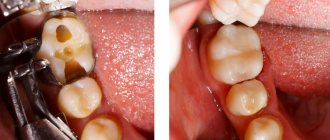Indications for placing a temporary filling
- Treatment of deep caries. After cleansing the tooth cavity from necrotic masses, the dentist places a medicinal solution that helps the dentin strengthen the layer between the pulp chamber and the open cavity.
- Diagnosis of the condition of the tooth with deep caries before installing a permanent filling.
- Acute pulpitis. A temporary intermediate composition is placed while the nerve is removed.
- Periodontitis. To relieve inflammation, an antiseptic or medicinal preparation is placed in the area of the tooth roots, which is then covered with light cement.
- Sanitation of dental canals before filling. The doctor cleans the canals, filling them with a disinfectant solution, then places a temporary filling.
- Prosthetics, restoration. The process of making an artificial crown or orthodontic structure takes several days. To protect against microbes, the open tooth cavity is closed with a temporary filling material.
Stages of placing a temporary filling:
- opening the tooth cavity, removing all affected dentin tissue;
- expansion, cleaning, treatment of dental canals;
- therapeutic stage (depending on the diagnosis, the nerve endings of the pulp are removed, medications are placed in the tooth cavity, and the canals are filled with temporary cement);
- The crown is closed with a temporary filling.
How to care.
Dentists recommend:
- refuse food and drink for at least 2 hours;
- refrain from too hard, sticky, viscous, cold and hot drinks;
- Chew food with the opposite side whenever possible;
- When cleaning, use only a brush with soft bristles;
- Be sure to rinse your mouth with antiseptic solutions after each meal.
If a temporary filling falls out or is partially destroyed, you should immediately consult a doctor to restore its integrity, so as not to provoke the entry of a bacterial environment into the tooth cavity.
When the temporary barrier or the medication underneath it has expired, the dentist removes it and replaces it with a permanent filling. First, the doctor will remove the medicine or temporary composition filling the tooth, disinfect the canals, treat the cavity with antiseptic solutions and install a permanent filling.
Material of manufacture
Requirements for temporary filling materials:
- no toxic effect on tooth structures (enamel, dentin, pulp) and mucous membranes of the oral cavity;
- safety for human health;
- chemical inertness and high resistance to saliva and aggressive environments (alkalies, acids);
- mechanical strength, wear resistance, ductility;
- lack of galvanization effect;
- maintaining shape and size during hardening;
- good radiopacity.
The choice of material for a temporary filling depends on the clinical case, age, individual characteristics of the body (the presence of allergies to certain substances), as well as how long the patient will wear it.
Composition of a temporary filling and its care
The temporary filling is harmless to the body because it consists of dental cement. You cannot wear such a structure all the time, as this can lead to further development of the disease and even complete tooth destruction.
The material for creating a temporary filling includes two main substances:
- Eugenol . It has a specific smell, somewhat reminiscent of cloves. It is highly valued in dentistry due to its sedative properties.
- Zinc Oxide Powder . Its properties depend on the substances with which it will be mixed. Used in filling solution to make eugenol more durable. When mixing the materials, it is possible to obtain a fairly solid solution, although at first it has a soft and brittle texture.
A temporary dental filling, unlike a permanent one, quickly wears out and falls out, so it needs to be used carefully. First of all, it is recommended not to eat for two hours after visiting the dental office. It would be a good idea to generally avoid eating hard and sticky foods during dental treatment. When brushing your teeth, you should try not to touch the area with the filling, so as not to seriously damage it.
Intermediate filling materials
- A paste based on zinc sulfate and kaolin allows you to restore the crown of the tooth.
- Karyosan has an analgesic and antiseptic effect.
- Vinoxol is an artificial dentin. Withstands chewing load for up to 1-2 months.
- Cement with zinc and eugenol. It is used for antiseptic treatment of tooth tissue and relief of the inflammatory process.
- Glass ionomer cement is used for temporary fixation of the prosthesis.
- One-component polymer materials are pastes with a viscous consistency that harden under the light of a special lamp.
Why do you need temporary dental filling in a nutshell?
Endodontic treatment or root canal treatment, a complex procedure that consists of instrumental and medicinal treatment of the canals, their temporary filling and permanent obturation
The goal of any endodontic treatment is to prevent the development of inflammatory processes and complications after pulpitis and periodontitis.
After providing access to the root canals, removing the inflamed or necrotic pulp and treating the tooth canals, Novodent+ doctors often temporarily (for 2-3 weeks) fill the canals with various medications. The purpose of this temporary filling is to sterilize the entire root canal system. Temporary filling materials have a pronounced antimicrobial effect. This stage of endodontic treatment is optional; it is used for acute and chronic periodontitis, abscess, and sometimes in the treatment of pulpitis in multi-rooted teeth.
The final stage of endodontic dental treatment is permanent obturation of the root canal (or canals, there may be several of them). And only after permanent filling do doctors begin to restore the tooth. After each stage of root canal treatment, a temporary filling is placed on the tooth, which protects the tooth from infection from the oral cavity and provides comfort to the patient between appointments with the doctor.
| Why do you have to re-treat dental canals? |
How long does it take to wear a temporary filling?
Depending on the material of manufacture, a temporary filling has different characteristics of strength and tightness and can last from several days to six months.
Average duration of use of a temporary filling:
- 2-3 days, if a drug is placed under the filling that destroys the nerve endings of the pulp;
- 7–10 days while treatment of the inflammatory process with periodontitis or pulpitis continues;
- 2-3 weeks - for the period of manufacture of the orthopedic structure;
- several months in special diagnostic cases (when treating a dental cyst, restoring dentin after deep caries).
It is necessary to strictly adhere to the timing of wearing temporary fillings. If the time period is extended, its integrity and sealing may be compromised, which will negatively affect the health of the tooth. Thus, arsenic-based paste, if not removed after 2-3 days, begins to penetrate the dentin through the tubules, destroying bone tissue.
How long a temporary filling can be worn is decided by the attending physician, depending on the diagnosis and the chosen treatment method.
Removing a temporary filling is a mandatory procedure before placing a permanent filling. After removal of the temporary composite, antiseptic treatment of the root canals and dental cavity is carried out. Next, a permanent filling is installed.
When is a temporary filling placed?
The situations in which a temporary fix is required are the same for adults and children:
- Diagnosis of deep caries. If the tooth is severely damaged, the doctor may install a temporary filling to determine whether or not the pulp needs to be removed. If the neurovascular bundle is not affected, the patient will feel comfortable. If the pulp is damaged, he will experience toothache, and in this case he will have to remove the neurovascular bundle, and then install a permanent filling.
- Treatment of pulpitis. To remove the pulp, the doctor can put a devitalizing paste inside the tooth and close the cavity with a temporary filling. After 1-7 days, a second visit to the dentist is necessary for further manipulations. In addition, it is advisable to install a “temporary cavity” after filling the canals with gutta-percha and sealant, if the dentist will install a pin or stump inlay, and also if there is a risk of exacerbation of inflammation.
- Treatment of periodontitis. Now it is possible to treat the pathology in 1 visit to a specialist. But in order to get a more predictable result, it is advisable to first eliminate the source of inflammation, then fill the tooth canals. In this case, a preparation based on calcium hydroxide is placed under the “temporary bark”, the period of action of which is from 1 to 4 weeks. After this, you need to place a new portion of the drug.
- Preparing teeth for prosthetics. In this case, the “makeshift” serves to protect the canals from food and pathogenic microorganisms entering them. The patient wears this filling until the dentures are made.
There are times when a doctor or patient does not have time to perform all the necessary procedures in one visit. Then the dentist will install a “temporary window” and name the date of the next visit.
Problems that arise when installing a temporary filling
Painful sensations can be caused by an incompletely destroyed nerve, infection under the filling, or the development of inflammation.
The filling falls out or crumbles. If you do not immediately consult a dentist, the treatment will have to begin again with re-sanitation of the canals, treating them with antiseptics to stop the development of infection.
An unpleasant taste in the mouth often indicates depressurization of the temporary coating, when the medicine from the tooth begins to leak into the oral cavity.
Darkening of the filling, swelling or redness of the gums may be signs of an allergic reaction to a component of the filling material.
When to see a doctor
If a tooth under a temporary filling constantly hurts, and the pain is bursting in nature and intensifies at night or during the day, you need to consult a dentist as soon as possible. The doctor examines the damaged tooth: if the filling has fallen out, he will put a new one and replace the medication. If the pain is caused by the development of inflammation or infection, the dentist will take action and change the treatment strategy.
You should immediately consult a doctor in the following cases:
- pain is accompanied by a feeling of swelling of soft tissues;
- the gums or cheek turn red, swell, and swelling appears;
- body temperature rises;
- the intensity of pain does not decrease within several days;
- when exposed to high or low temperatures, the pain intensifies;
- signs of general intoxication of the body develop;
- lymph nodes (primarily submandibular) enlarge and become painful on palpation;
- there is an unpleasant odor from the mouth;
- The temporary filling falls out, its tightness is compromised: cracks and chips form in the cementing material.
In such cases, the dentist will open the filling, remove the medicine and any remaining filling material. The doctor will disinfect the hole, clean and dry the root canals. If necessary, seal them with sealer and install a pin. After such treatment, an x-ray is performed - it allows you to evaluate the quality of treatment. Next, the dentist can re-install a temporary filling or change therapeutic methods.

